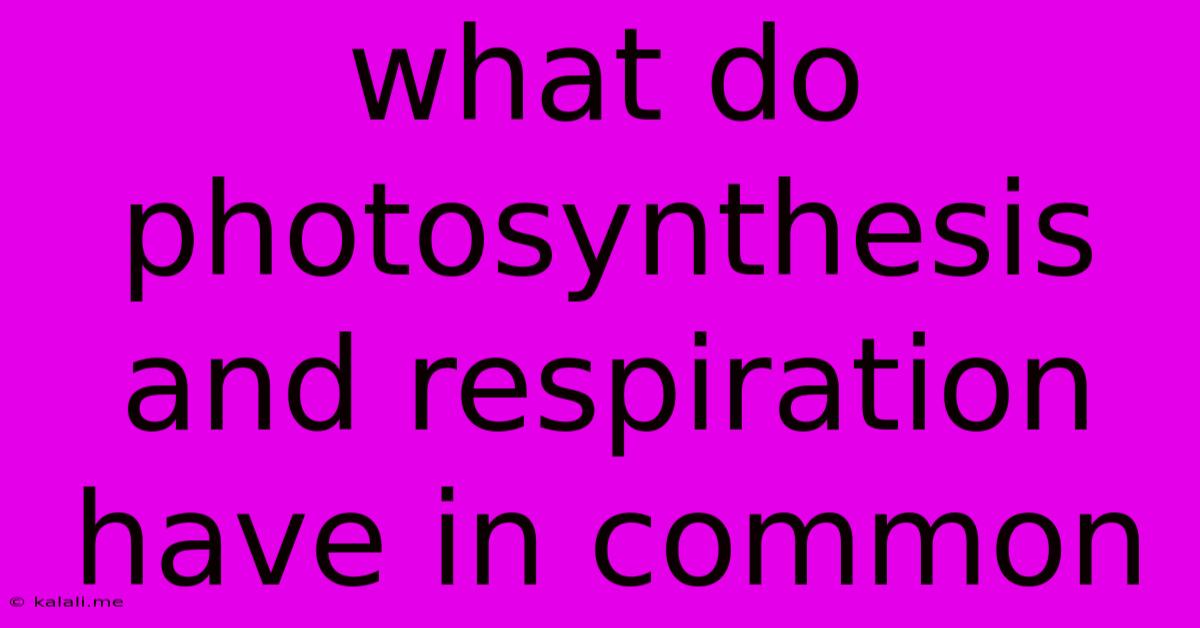What Do Photosynthesis And Respiration Have In Common
Kalali
May 08, 2025 · 3 min read

Table of Contents
What Do Photosynthesis and Respiration Have in Common? A Look at the Cellular Dance of Life
Photosynthesis and respiration are often presented as opposing processes, like two sides of a coin. While they are indeed reciprocal reactions, crucial for the balance of life on Earth, they share surprising similarities at a fundamental level. This article delves into those commonalities, exploring the interconnectedness of these vital cellular processes. Understanding their shared mechanisms offers a deeper appreciation for the intricate workings of life itself.
Key Similarities Between Photosynthesis and Respiration:
Both photosynthesis and cellular respiration are metabolic pathways, meaning they involve a series of chemical reactions within cells. These reactions are essential for energy conversion and the maintenance of life. Let's examine their core similarities:
1. Energy Transformation: The Heart of the Matter
At their core, both processes are fundamentally about energy transformation. Photosynthesis captures light energy and converts it into chemical energy stored in glucose (a sugar). Cellular respiration, conversely, breaks down glucose to release that stored chemical energy in the form of ATP (adenosine triphosphate), the cell's primary energy currency. While the direction of energy flow is opposite, both processes are all about harnessing and converting energy to power cellular functions.
2. Electron Transport Chains: The Shared Mechanism
A remarkable similarity lies in their use of electron transport chains. Both photosynthesis and respiration utilize these chains of protein complexes to move electrons, creating a proton gradient across a membrane. This gradient is then used to generate ATP through chemiosmosis. The fundamental mechanism of using electron flow to drive ATP synthesis is a common thread connecting these seemingly opposite reactions. This process, crucial for energy production, highlights the elegant efficiency of nature's design.
3. Redox Reactions: The Exchange of Electrons
Both pathways heavily rely on redox reactions, or oxidation-reduction reactions. These reactions involve the transfer of electrons between molecules. In photosynthesis, carbon dioxide is reduced (gains electrons) to form glucose, while water is oxidized (loses electrons). In cellular respiration, glucose is oxidized, releasing electrons that are passed down the electron transport chain, while oxygen is reduced to form water. The fundamental exchange of electrons is a key component of both processes, facilitating energy transfer.
4. Enzyme Involvement: Catalysts for Life
Both photosynthesis and respiration are intricate processes driven by a large number of enzymes. These biological catalysts significantly speed up the rate of chemical reactions, ensuring the efficient flow of the pathways. Without these specific enzymes, both processes would proceed far too slowly to support life. The reliance on specific enzymes to mediate each step emphasizes the high degree of regulation and control needed in these vital cellular pathways.
5. Membrane-Bound Organelles: Compartmentalized Efficiency
In eukaryotic cells (cells with a nucleus), both photosynthesis and cellular respiration are compartmentalized within specific organelles. Photosynthesis takes place primarily in chloroplasts, while cellular respiration occurs mainly in mitochondria. These membrane-bound organelles create microenvironments that optimize the efficiency of the respective pathways, separating them from other cellular processes and preventing interference.
Conclusion: A Symbiotic Relationship
Photosynthesis and respiration, while seemingly distinct, share remarkable similarities at the molecular level. Their common reliance on electron transport chains, redox reactions, and enzyme catalysis underscores the elegant efficiency and interconnectedness of life's fundamental processes. Understanding these shared features provides a deeper appreciation of the intricate dance between energy capture and release that sustains all life on Earth. This reciprocal relationship, a continuous cycle of energy transformation, is a testament to the remarkable ingenuity of biological systems.
Latest Posts
Latest Posts
-
How Many Parallel Lines Does A Rectangle Have
May 09, 2025
-
How Many Cm In 17 Inches
May 09, 2025
-
How Do You Solve Multi Step Equations With Fractions
May 09, 2025
-
The Measure Of The Force Of Gravity On An Object
May 09, 2025
-
2 3 4 As An Improper Fraction
May 09, 2025
Related Post
Thank you for visiting our website which covers about What Do Photosynthesis And Respiration Have In Common . We hope the information provided has been useful to you. Feel free to contact us if you have any questions or need further assistance. See you next time and don't miss to bookmark.